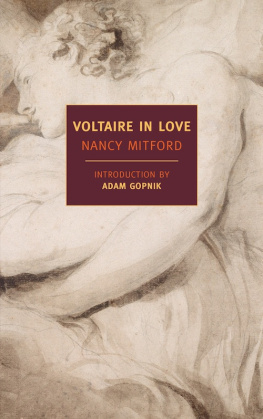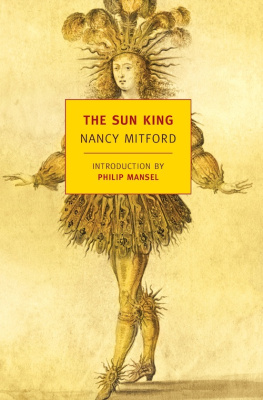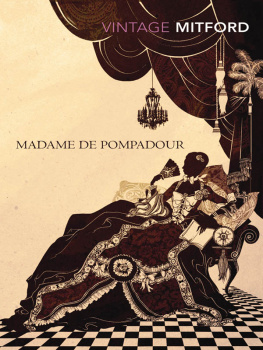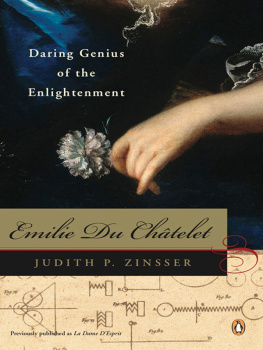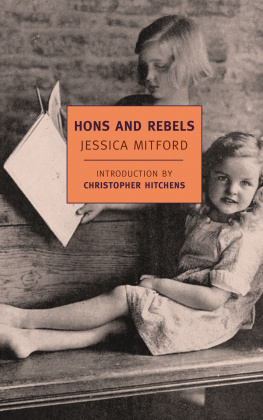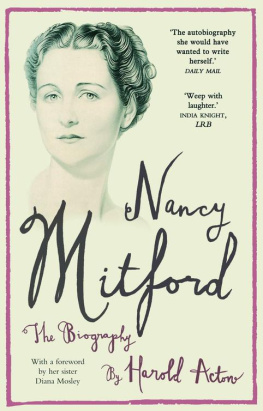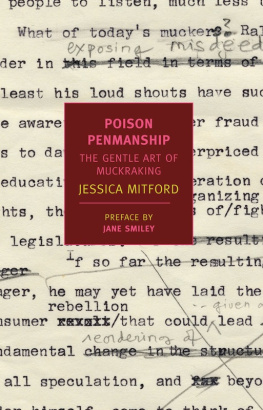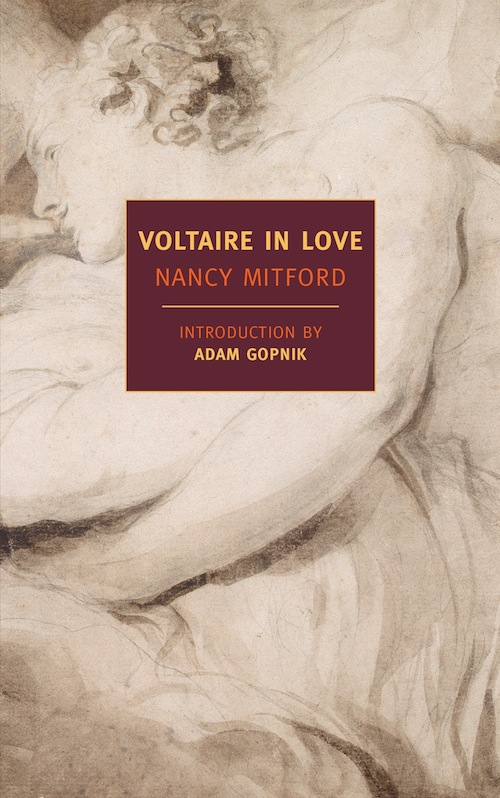NANCY MITFORD (19041973) was born into the British aristocracy and, by her own account, brought up without an education, except in riding and French. She managed a London bookshop during the Second World War, then moved to Paris, where she began to write her celebrated and successful novels, among them The Pursuit of Love and Love in a Cold Climate, about the foibles of the English upper class. Mitford was also the author of four biographies: Madame de Pompadour (1954), Voltaire in Love (1957), The Sun King (1966), and Frederick the Great (1970)all available as NYRB Classics. In 1967 Mitford moved from Paris to Versailles, where she lived until her death from Hodgkin's disease.
ADAM GOPNIK has been a staff writer at The New Yorker since 1987, writing often on French life and literature. His many books include Paris to the Moon, an anthropology of modern French manners, and The Table Comes First, an essay on the philosophy of eating. He has also written introductions to new editions of works by authors such as Balzac, Alain-Fournier, Hugo, and Maupassant. In 2012, Gopnik was made a Chevalier de lOrdre des Arts et des Lettres of France.
OTHER BOOKS BY NANCY MITFORD
PUBLISHED BY NYRB CLASSICS
Frederick the Great
Madame de Pompadour
The Sun King
VOLTAIRE IN LOVE
NANCY MITFORD
Introduction by
ADAM GOPNIK
NEW YORK REVIEW BOOKS

New York
THIS IS A NEW YORK REVIEW BOOK
PUBLISHED BY THE NEW YORK REVIEW OF BOOKS
435 Hudson Street, New York, NY 10014
www.nyrb.com
Copyright 1957 by Nancy Mitford
Introduction copyright 2012 by Adam Gopnik
All rights reserved.
First published in Great Britain by Hamish Hamilton, 1957
Cover image: Jean-Honor Fragonard, Cupid and Psyche; RMN-Grand Palais / Art Resource, NY
Cover design: Katy Homans
The Library of Congress has cataloged the earlier printing as follows:
Mitford, Nancy, 19041973.
Voltaire in love / by Nancy Mitford; introduction by Adam Gopnik.
p. cm. (New York Review books classics)
Includes bibliographical references and index.
ISBN 978-1-59017-578-1(alk. paper)
1. Voltaire, 16941778Relations with women. 2. Du Chtelet, Gabrielle
milie Le Tonnelier de Breteuil, marquise, 1706-1749.3. Authors, French
18th centuryBiography. 4. ScientistsFranceBiography. 5. Mistresses
FranceBiography. I. Title.
PQ2103.D7M52012
848'.5O9dc23
[B]
2012019447
ebook ISBN: 978-1-59017-593-4
v1.0
For a complete list of books in the NYRB Classics series, visit www.nyrb.com or write to:
Catalog Requests, NYRB, 435 Hudson Street, New York, NY 10014
Contents
Introduction
Voltaire in Love, first published in 1957, is Nancy Mitfords retelling of the story of the fifteen-year-long love affair between Voltaire, the dominant writer of the European eighteenth century (No man has ever had so much fame in his lifetime as Voltaire, said Dr. Johnson, no admirer), and the Marquise du Chtelet, known as milie, an aristocrat who by an exemplary act of will made herself an important scientist and philosopher at a time when women were not expected to be either and were most often mocked when they managed it.
Mitfords story is really two stories: One tells how Voltaire and milie worked together, mostly at her chteau in Cirey (with her patient, cuckolded husband in odd, spare-bedroom attendance), to bring Newtonian science to Cartesian France, producing both scientific papers and a masterpiece of popular explanation, her translation of Newtons Principia. The other, counterpointed story tells of how they came, truly, to love each othera love at least briefly of the body as well as of the mind and soul, and how that love worked its twisted, original, difficult way to a decent, amiable conclusion in friendship. Its a relationship that anticipates many other love affairs in succeeding centuries between smart spoiled men and bright difficult women. That lady whom I look upon as a great man, Voltaire wrote of her. She understands Newton, she despises superstition and in short she makes me happy. George Eliot and George Henry Lewes, Chopin and George Sand, J. S. Mill and Harriet Taylorall those other love affairs where mind and body got twisted together in a pretzel of passion and philosophy are prefigured in this first one.
That sounds quite grand, but when Nancy Mitford decided to tell their story grand was the last thing she made it seem. Voltaire in Love was one of a series of popular histories of French figures that Mitford wrote for a mostly English, and then later American, audience after her arrival in Paris during the 1950s, where she lived at 7 rue de Monsieur, in the heart of the Faubourg Saint-Germain. She had come to live in France in order to be near her Colonel, Gaston Palewski, a brave Gaullist whom she had met in London during the war. She was madly in love with him, and he, more sporadically, was in love with her. Installed in France with an existing reputation for madcap, borderline Wodehousian novels about her bizarre upbringing as an aristocratic Englishwoman, she began to earn a living by writing popular books of French history. She wrote books about Madame Pompadour and Louis XIV and, here, about Voltaire. (A small literary tribute: I made my own image of Mitford in Paris into the heroine of my adventure story The King in the Window, in the person of Mrs. Pearson, and gave her the same Paris address.)
Mitfords books about France were offered, and patronized by critics, as pop history, drawn from what academic historians call, primly, secondary sources, that is, accounts by other historians. This is a practice that sounds easy and is in its way as hard as archival research, since it involves selection and decisive reshaping from a literature already overabundanttopiary trimming rather than spadework. She recognized Voltaire himself as a master of this kind: He thought that an historical study should be composed like a play, with a beginning, a middle and an end, not a mere collection of facts: If you want to bore the reader, tell him everything.
The play she chooses to put on is a comedy, at times a farce. Her Voltaire, and to a lesser degree her marquise, are mostly ludicrous in their relation with each other and often ridiculous in their appearances in the world. Mitfords Voltaire is genuinely in love, and, after his forced sojourn in London in the 1720s, really did see that Newtons grand, universe-spanning physics had an explanatory power that Descartess alternative physics, dominant in France, with its cosmic whirlpools and vortices, lacked. (Though, as Mitford shrewdly remarks, Voltaires liking for English politics, liberal at least compared with French autocracy, and his desire to shake up his countrymens fatal complacency, had something to do with this apostasy.)
But his actions in this book are taken up less in watching the stars and calculating their paths than in the furious pursuit of his literary enemies here on earth, and mostly in Paris. Detailed accounts of long-forgotten literary conspiracy and vendetta, at once remote in their particulars and entirely familiar in their shape, fill the book: Voltaire gets engaged in squabbles with a now forgotten writer and editor, the Abb Desfontaines, whom he thought a monster of ingratitude and a sodomite besides, feeds his own publisher with work that he is later outraged to see in print, libels other writers mercilessly, and then shrieks with rageand even goes to lawwhen he is libeled and mocked in turn. Chapter 10 alone gives a perfect picture of the bewildering, incestuous, farcical feuding that still remains a constant of French intellectual life: Mme. du Chtelet writes a letter to Mme. de Champbonin asking for her support in Voltaires latest literary war, and she in turn writes to The-riot, who pities Voltaire but refuses to sign his petition, and, it turns out, is, shockingly, going to publish his own letter to Mme. du Chtelet in a competing paper run by the Abb Prevost. More rivers of mingled ink and tears flowed to Paris from Cirey is Mitfords dry comment.

